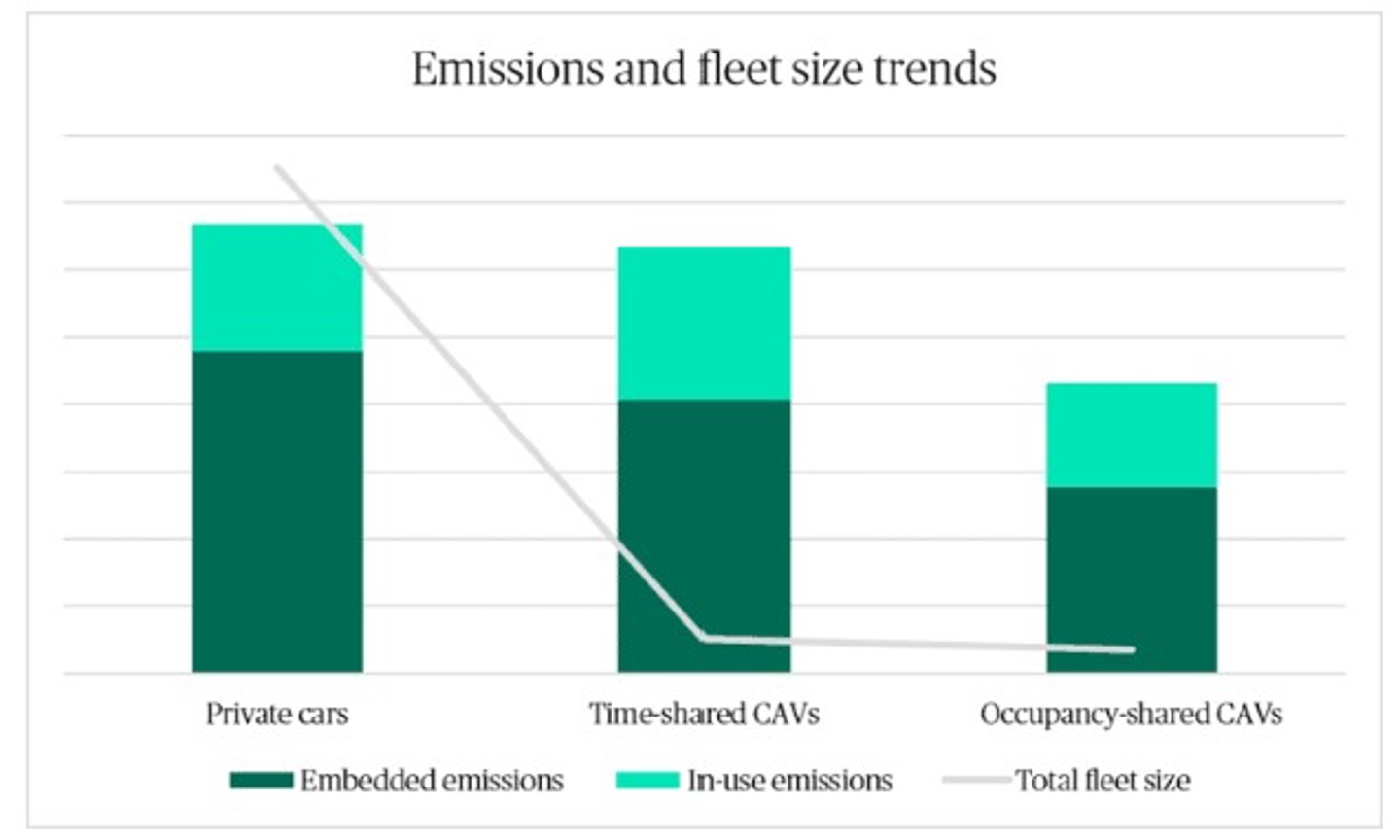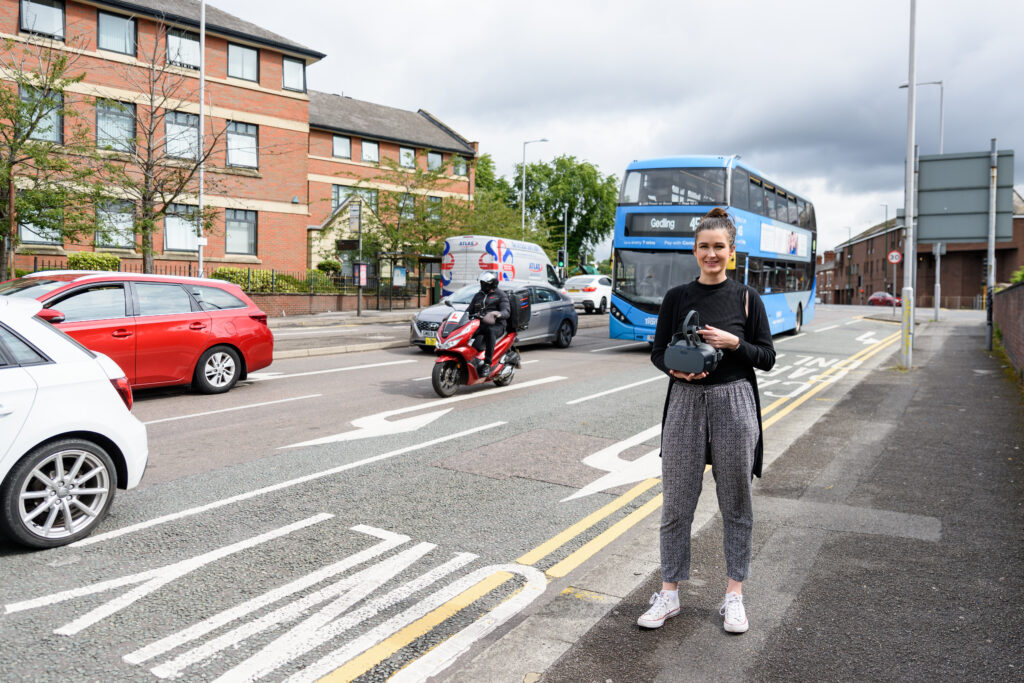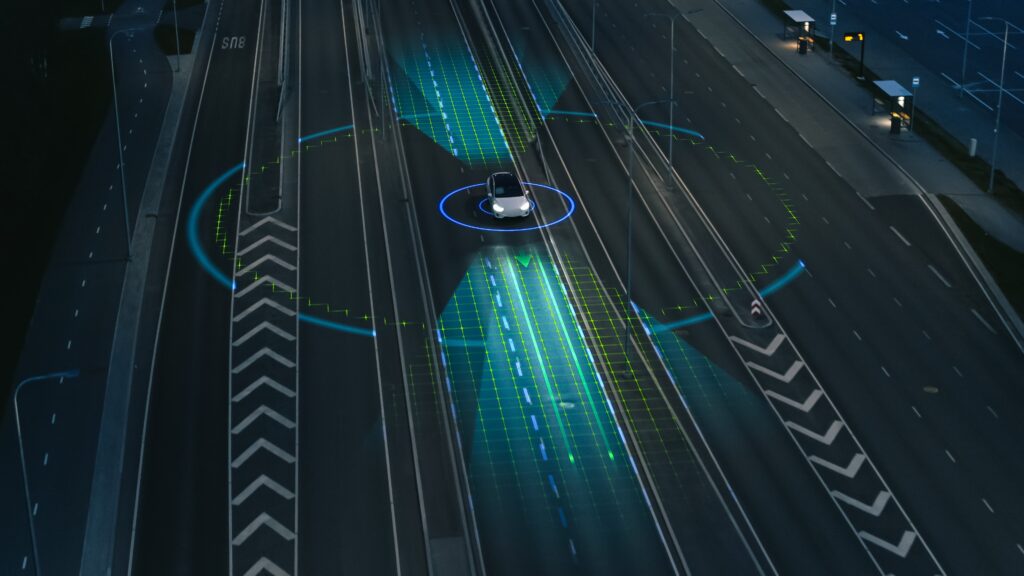This is because the CAVs would have to travel extra “empty” miles in order to pick up passengers, leading to higher use phase emissions (assuming the grid isn’t fully-decarbonised). While the fleet size at any one time could be far smaller, the rate of manufacture of vehicles would stay the same (as each vehicle would fulfil roughly the same passenger-miles demand over its life), so this wouldn’t reduce embedded emissions from manufacturing.
Autonomous vehicles: is sharing really caring for the planet?
An oft-cited benefit of Connected and Automated Vehicles (CAVs) is that shared, automated, electric, on-demand services will be great for the environment, because far fewer vehicles will be needed to meet the same demand.

Given this, we thought it important to explore the details that may swing it one way or the other: do private vehicles always get the full potential miles out of a vehicle before it is scrapped, and can shared-occupancy journeys tip it back in favour of the shared CAVs? Our (fairly basic) model suggests:
- There is a small improvement in carbon emissions from robotaxis services, as the empty miles are outweighed by extracting more lifetime miles from each vehicle.
- For robotaxi services that combine trips (i.e. shared occupancy), this becomes a significant improvement, so CAVs-as-a-service clearly have a role to play in decarbonising transport.
Introduction
The days of privately owned vehicles sitting still and unoccupied for 95% of the time may soon be a thing of the past. In their place, shiny state-of the-art autonomous vehicles will roam the streets ready for our every travel whim at the click of a button. To sweeten the deal further, the efficiency of a shared autonomous vehicles fleet will even be better for the environment. Right?
Well, reports on the effects of companies such as Uber and Lyft suggest that ride-hailing services can result in increased congestion and no reduction in private car ownership. Thus, such reports conclude that ride-hailing companies are contributing to the problem they claim to be solving.
We believe that autonomous vehicles will eventually be more cost-effective and convenient for the user, and therefore provide a genuine alternative to private ownership unlike the ride-hailing services of today.
Shared services are nothing new. Ride-hailing and even traditional taxi services are an example of time sharing: where one vehicle is used to fulfil the travel demands of multiple passengers – but not at the same time. Occupancy sharing can be achieved through ‘carpooling’ but, to operate at scale, needs technology that matches passengers travelling in the same direction to jointly occupy the same vehicle for a portion of their journey.
Shared vehicle services lead to a reduction in the minimum fleet size required to meet passenger travel demand through higher vehicle utilisation rates. However, the fleet must travel more miles overall to achieve this due to the necessity for ’empty miles’. The higher utilisation rate also means that shared vehicles are scrapped and replaced more frequently than private cars, leading to no overall reduction in the rate of vehicle production.
We set out to model to what extent replacing private ownership with shared CAV services can reduce carbon emissions in Great Britain (GB) using time and occupancy sharing scenarios. Previous models have worked this out using a densely populated urban area, but we have made some key assumptions to apply this logic to the whole GB region.
Where’s the carbon coming from?
The UK government’s ban of sales of combustion engine vehicles by 2030 sets the path towards electrification. We have modelled all vehicles to be battery electric (BEVs), whether privately owned or operated as a service, so that the true effects of sharing can be seen.
However, this begs the question: if all vehicles are electric, where are the carbon emissions coming from?
The carbon lifecycle of any vehicle is largely dominated by its manufacture and use phases, with transportation and disposal of parts being fairly insignificant. The ‘zero emission’ status awarded to BEVs’ use phase only accounts for the tailpipe emissions – there is still carbon attributed to electricity consumed per kilometre travelled.
Looking at the manufacturing phase, lithium-ion battery production is carbon intensive and the battery of a BEV accounts for approximately half of the embedded carbon emissions of each vehicle. Meanwhile, the use phase emissions of a BEV tend to zero as the grid decarbonises. With the UK’s grid set to be net zero by 2050, the embedded carbon in BEV production becomes more significant over time.
How can sharing help reduce carbon emissions?
Fleet size – embedded emissions
The embedded emissions in the manufacture and disposal of a vehicle can be averaged over its lifespan. Vehicle lifespan can be measured in distance (wear) or time (corrosion and depreciation) with the average lifespans of private cars in the UK being 150,000km and 14 years respectively. Most previous work has simply assumed that a vehicle’s lifespan is determined only by mileage, but for our analysis the relationship between years and miles is critical so we’ve created a model considering both. We’ve assumed the most basic relationship possible: the vehicle’s life ends at whichever measure occurs first, the mileage or age life limit (based partly on Held et al, 2021) – we didn’t find any evidence of more sophisticated models in the literature). So for example, once a vehicle reaches 14 years old, corrosion factors and the economic cost of repairs compared to its residual value mean it will often be scrapped even if it only has 100,000km on the clock.
If it is assumed that private vehicles only serve the travel demand of their owners, then a fleet of vehicles shared by time reduces the minimum fleet size needed to meet demand. So, can we assume that a smaller fleet results in fewer embedded emissions? Not exactly. Time sharing of vehicles reduces the time taken to reach a vehicle’s mileage lifespan and thus increases the frequency of their replacement. This means cars need to be produced more often and the embedded emissions per year remains the same. In our model you will see small improvements in embedded emissions per year for time-shared CAVs — but this is down to the shared vehicles always reaching their mileage lifespan, so being able to distribute their embedded emissions over more km than a privately-owned fleet.
So, to see a significant reduction in carbon emissions, we must consolidate journeys through occupancy sharing. This means that fewer vehicles and fewer occupied vehicle km are required to fulfil the passenger travel demand, which will lead to a carbon reduction if and only if the introduction of empty miles doesn’t negate that.
Distance travelled – use phase emissions
We assume private vehicles are not fully automated, always require a driver and therefore have no unoccupied driving time or “empty miles”.
For last mile journeys, people have relatively unique start and points so to pick someone else up en-route usually requires additional wait time and additional miles. And, just like taxis, autonomous vehicles will have to travel without a passenger at times to reach a pick-up location – these are referred to as empty miles.
So, for fair comparison of a private versus shared fleet system, additional vehicle miles must be added to the shared vehicles.
Carbon calculator
To quantify the carbon savings of a shared vehicle network, we created a model to compare the greenhouse gas emissions (measured in equivalent carbon dioxide (CO2e)) emitted by the private fleet with that of an optimised shared fleet with the scenarios of time-sharing alone or time- and occupancy- sharing together. This model can be downloaded here.
By simplifying the system using key assumptions listed here, we were able to get some relative carbon outputs from the model for private, time shared and occupancy shared based on ‘most likely scenario’ comparison. The results are presented below.

The results suggest that while time-shared CAVs can reduce carbon emissions slightly, it is only when occupancy-shared CAVs start to be widely used that the real decarbonisation benefits of shared CAVs will kick in.
It also shows that moving to shared autonomous vehicles could result in only 2 million cars in use, compared to the 31 million we currently have on GB roads. This doesn’t lead to an automatic carbon saving but frees up lots of land which could be repurposed with environmental benefits.
Sensitivity analysis
There is a lot of uncertainty in the data due to the fact that fully self-driving CAVs aren’t yet in production. Therefore, we wanted to analyse the impacts of some unknowns on the total carbon emissions, in particular the difference between the total carbon emissions of private cars, time shared CAVs, and occupancy shared CAVs when compared to the baseline.


This analysis suggests that the benefit of time shared CAVs operating as a service is highly sensitive to the number of empty miles they have to drive to reach their passengers and the grid emissions– and they could potentially be worse than private cars for the environment. On the other hand, occupancy sharing services result in lower carbon emissions than private cars under every scenario we tried out.
Increased lifespan of vehicles also has a big impact on total carbon emissions. Our model assumes private vehicles keep the same 14-year maximum service life, which means private vehicle emissions remain the same. However, emissions are drastically reduced for both time shared and occupancy shared CAV services. The RUBICON project is exploring engineering for ultra-durable CAVs.
So, is sharing the best way to care for the planet?
We can conclude that time sharing CAVs alone is not enough to significantly reduce carbon emissions to reach Net Zero targets (but will free up a lot of space from a reduced fleet size!).
A shift to more occupancy sharing facilitated by CAVs is the way to go, but should be accompanied by improving the durability of CAVs and decarbonising the grid for maximum emissions reduction.
What’s next?
It’s not just passengers who should embrace sharing, but almost more importantly vehicle operators should share passengers. Creating an interoperable network of autonomous vehicle operators means a shared customer base which increases the efficiency of the system by increasing the likelihood of demand being nearby and of journey consolidation potential. This reduces wait times and therefore improves quality of service for customers but also reduces the empty miles travelled by CAVs which is a win for the CAV operator, the transport network, and the environment.
We only modelled the effects of consolidating two journeys at a time, i.e. doubling occupancy, but interoperability may make it more feasible to simultaneously consolidate more journeys. The difficulty is that this may lead to the requirement of larger vehicles with greater embedded emissions per km, therefore further modelling would be required to verify the overall carbon impacts.
We also note that with a significantly reduced fleet size (29 million cars off the road!) there is great potential to repurpose parking land to uses which benefit society.
Maximising interoperability, repurposing land use, working out what will make the travelling public comfortable with sharing a vehicle, and many other policy interventions are necessary to realise the full decarbonisation potential of shared fleets. The Connected Places Catapult is working with the Centre for Connected and Autonomous Vehicles (CCAV) to explore this further.















